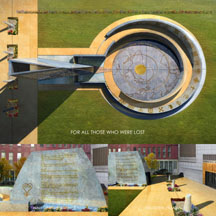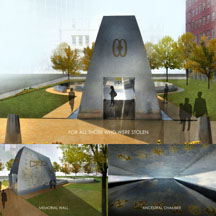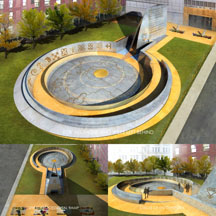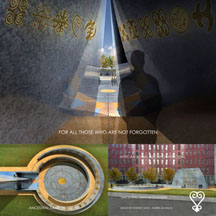Description from Rodney Leon, AARRIS Architects
For all those who were lost
For all those who were stolen
For all those who were left behind
For all those who are not forgotten
1 Education
We believe the African Burial Ground Memorial must communicate and educate. As the ancient story tellers did before, it must communicate our history for generations to come. As one engages the monument both visually and physically, one must become enlightened to the sacred, cultural and historical significance of the site through the medium of space, form, language, symbol and ritual.
2 Urban presence
We believe the African Burial Ground Memorial must have a significant and powerful urban presence. The African Burial Ground Memorial must be seen at a distance and stand out to compete visually and formally with the complex fabric of the city.
We believe the African Burial Ground Memorial must operate at the scale of the city, group and individual. The African Burial Ground Memorial must be able to flexibly accommodate groups of people congregating communally within and around the memorial in celebration and reflection in order to function at the intermediate and large scale of the city. The African Burial Ground Memorial must provide intimate scale spaces for personal reflection and contemplation in order to function at the scale of the individual.
We believe the African Burial Ground Memorial must be seamlessly integrated as part of a sequence of public urban spaces commemorating the history of African people in Lower Manhattan. It shall act as an intermediate space connecting the public procession beginning with the Interpretive Center and Ring Shout at 290 Broadway and culminating with Triumph of the Spirit at Foley Square. The African Burial Ground Memorial is on axis with the ring shout cosmogram and may be accessed by insertion of glass doors in the façade of 290 Broadway facing the Burial Ground.
3 Culture
We believe the African Burial Ground Memorial design must be culturally contextual. The language, form, function and ritual behind the elements constituting the memorial shall be inspired and derived from African precedents. Historical precedent for our form comes from both traditional and monumental African architectural typology. These forms are synthesized into a unique contemporary architectural expression.
4 Symbol
We believe the African Burial Ground Memorial design must utilize spiritually and culturally recognizable iconography; an image that identifies the site and memorial universally in people’s minds.
5 Spirituality
We believe the Memorial Site must be designed as a Sacred Site and the Memorial a Sacred Object. In Congo Cosmology the cosmogram represents the crossroads between the realm of the living and that of the ancestors. It reflects the eternal movement of the soul as it proceeds from birth, life, death and re-birth. The ABGM is a three dimensional cosmogram; a dynamic expression of this idea. Through the form of the Ancestral Chamber the African people here are no longer anonymous. Their collective energy and spirit thrusts upward out of the ground toward heaven to reclaim their honor and place in history. Simultaneously we are encouraged to spiral downward into sacred ground close to level of original interment and closer to reuniting with the spirit of our ancestors
6 International
We believe the ABG Memorial must be international. The ABGM is global project. It is a place of pilgrimage. This monument must speak to all people. Its beauty, meaning and power should be expressed in a manner that transcends difference and bring people together
7 Participatory
We believe the ABG Memorial must be interactive and participatory. The element of a ritual such as libation makes visitors active participants through verbal and physical action and movement. One should touch the monument. One should read from the monument. The monument must be able to act as a place of offering. It is a living breathing place.
For all those who were lost
For all those who were stolen
For all those who were left behind
For all those who are not forgotten
We commemorate this African Burial Ground with an “Ancestral Libation Chamber.” Through Seven Elements the Ancestral Chamber will serve to physically, spiritually, ritualistically and psychologically define the location where the historic re-interment of remains and artifacts of 419 Africans has taken place. It will also serve to acknowledge the site as a “Sacred Place” where thousands of Africans are currently buried.
1 Wall of remembrance
As one happens by the North Wall facing Duane Street you are immediately struck by the scale and detail of a highly polished wall of granite inscribed with text arranged chronologically describing major historical events that have contributed to the creation of the African Burial Ground. At this moment begins a process of enlightenment and education.
2 Ancestral pillars
On October 4, 2003 7 large sarcophagi containing the remains of exhumed African descendants were ceremonially re-interred. 4 granite pillars mark their location, contents and date of interment. The Ancestral Pillars serve as markers and guardians for the entrance to the Ancestral Libation Chamber. It is appropriate to place flowers and other offerings at the base of the Ancestral Pillars.
3 Memorial wall
The original boundaries of the African Burial Ground extend significantly beyond the boundaries of the memorial site itself. Over time these original boundaries have been lost. Inscribed on the Southern wall of the Ancestral Libation Chamber is a map. The map on this wall serves to clarify the extent of the burial grounds actual size through lower Manhattan.
4 The ancestral chamber
The spiritual form of the Ancestral Chamber rises out of the ground 24 feet above street level. This height represents the distance down one would have to excavate in order to reach the level of the original burial ground. The form of the Ancestral Chamber is a synthesis of traditional and monumental African archetypes representing the soaring African spirit embracing and comforting all those who enter. Their collective energy and spirit thrusts upward out of the ground toward heaven reclaiming their honor and place in history. These ancestral Africans were taken from their home land through a “Door of No Return” One enters the Ancestral Chamber through the “Door of Return.” The Ancestral Chamber is a vessel that serves to take us back to an original place where we all began. It provides a sacred space for individual contemplation, reflection, meditation and prayer.
5 Circle of the diaspora
Signs, symbols, images of the African Diaspora are engraved around the perimeter wall encircling the Libation Court. These symbols come from different areas and cultures throughout the Diaspora especially Africa, Latin America and the Caribbean. Symbolic meaning is described below the image. As one circumambulates around the perimeter of the court and spirals down the processional ramp, these symbols present themselves as a reminder of the complexity and diversity of African culture’s manifestation. They all come together to form a communal place and a reminder of the ABG being an international center of gathering.
6 Spiral processional ramp
The Spiral Processional Ramp descends down 6’ below street level thereby bringing the visitor physically, psychologically and spiritually closer to the ancestors and original interment level. The ramp and stairs serve as bridges between the living and the spiritual realm. They symbolize the process of transcendence from physical to spiritual and passage from profane to sacred. The process will evolve from the public “secular” space of the city to the spiritual space of the Libation court and culminate in the sacred space of the Ancestral Chamber. Offerings may be carried down the Spiral Processional Ramp into the Burial Ground Plaza.
7 Ancestral libation court
The Ancestral Libation Court is situated on axis with the Ancestral Chamber. It is located 6’ below street level, providing a physical and psychological separation from the public activity of the surrounding urban environment. Inscribed on the surface of the Libation Court is a map of Africa showing the migration of culture to North America, South America, Central America and the Caribbean. The Libation Court is a communal gathering place where small to medium-scale public cultural ceremonies may occur. This spiritual space is where re-consecration of the African Burial Ground site will continually take place during libation or other ceremonial rituals. The ritual of “libation” is the act which will serve as an offering and an acknowledgement linking past, present and future generations in the spirit of Sankofa.
For all those who were lost
For all those who were stolen
For all those who were left behind
For all those who are not forgotten

 U.S. General Services Administration
U.S. General Services Administration



